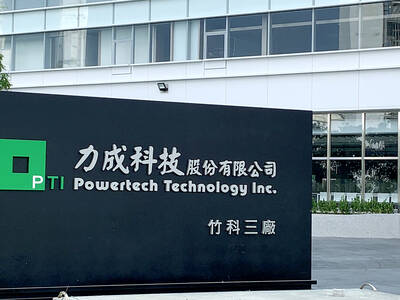Google’s bid to dominate the mobile phone operating software market got a boost on Tuesday when Taiwanese handset maker HTC (宏達電) unveiled the third phone based on the US Internet giant’s technology.
The touch-screen HTC Magic is to be sold by British network operator Vodafone and its subsidiaries in Britain, France, Germany and Italy, the companies said at the Mobile World Congress in Barcelona.
Rival developers are battling to create the dominant operating system for mobile phones, with Google and its Android system competing with Microsoft, Nokia, an open-source Linux-based project and Blackberry.
“We are very excited to be introducing our first Android-powered smartphone in the spring,” said Patrick Chomet, global director of terminals for Vodafone.
On Monday, Chinese manufacturer Huawei (華為) had revealed its first mobile phone that will run Android, meaning there are at least three “Google” phones now developed. LG and Samsung have promised their versions this year.
The first phone to use the Google software was launched by HTC last October in partnership with German network operator T-Mobile.
“For a new platform with open source, I am impressed with the momentum growing behind Android,” said Gavin Byrne, an analyst at telecom research group Informa.
Android is “open-source,” meaning that the basic code is free for phone manufacturers and is available to other software developers who are encouraged to build applications to add on.
Byrne said he still expected the system by Nokia, called Symbian, to remain dominant in the next five years, but that Android would establish itself as an alternative.
Google is hoping to establish its operating system as an industry standard, which would help drive users to its services, which include Internet search, maps and chat.
HTC chief executive Peter Chou (周永明) stressed that people would increasingly access the Internet from their mobile devices rather than in an office or at home — particularly in the developing world.
Google has recognized this, which is the reason it is so keen to establish itself and its applications in the mobile industry, analysts say.
“There is a generation of people from various parts of the world who have never experienced Internet on a PC yet, but they will experience Internet on these mobile devices,” Chou said.
Andy Rubin, head of Android at Google, said the project had gone from concepts and prototypes to realization in the last 12 months.
The first prototypes for Android were put on display at the World Mobile Congress last year, creating a buzz among the crowds.
“Last year there was a lot of promises and expectations. We delivered on those promises,” Rubin said.
He said that Android could reduce the manufacturing cost of a handset by 20 percent because the operating system is free.
“Sometimes we don’t even know it when they [manufacturers) announce phones with Android. They don’t need to sign a contract with us,” he said, adding that he did not judge success “by the number of handsets.”
The HTC Magic is a slim, tablet-shaped device with touch-screen control that, like other high-end phones launched at the Mobile World Congress, has a resemblance to the top-selling Apple iPhone.

US sports leagues rushed to get in on the multi-billion US dollar bonanza of legalized betting, but the arrest of an National Basketball Association (NBA) coach and player in two sprawling US federal investigations show the potential cost of partnering with the gambling industry. Portland Trail Blazers coach Chauncey Billups, a former Detroit Pistons star and an NBA Hall of Famer, was arrested for his alleged role in rigged illegal poker games that prosecutors say were tied to Mafia crime families. Miami Heat guard Terry Rozier was charged with manipulating his play for the benefit of bettors and former NBA player and

The DBS Foundation yesterday announced the launch of two flagship programs, “Silver Motion” and “Happier Caregiver, Healthier Seniors,” in partnership with CCILU Ltd, Hondao Senior Citizens’ Welfare Foundation and the Garden of Hope Foundation to help Taiwan face the challenges of a rapidly aging population. The foundation said it would invest S$4.91 million (US$3.8 million) over three years to foster inclusion and resilience in an aging society. “Aging may bring challenges, but it also brings opportunities. With many Asian markets rapidly becoming super-aged, the DBS Foundation is working with a regional ecosystem of like-minded partners across the private, public and people sectors

BREAKTHROUGH TECH: Powertech expects its fan-out PLP system to become mainstream, saying it can offer three-times greater production throughput Chip packaging service provider Powertech Technology Inc (力成科技) plans to more than double its capital expenditures next year to more than NT$40 billion (US$1.31 billion) as demand for its new panel-level packaging (PLP) technology, primarily used in chips for artificial intelligence (AI) applications, has greatly exceeded what it can supply. A significant portion of the budget, about US$1 billion, would be earmarked for fan-out PLP technology, Powertech told investors yesterday. Its heavy investment in fan-out PLP technology over the past 10 years is expected to bear fruit in 2027 after the technology enters volume production, it said, adding that the tech would

YEAR-END BOOST: The holiday shopping season in the US and Europe, combined with rising demand for AI applications, is expected to drive exports to a new high, the NDC said Taiwan’s business climate monitor improved last month, transitioning from steady growth for the first time in five months, as robust global demand for artificial intelligence (AI) products and new iPhone shipments boosted exports and corporate sales, the National Development Council (NDC) said yesterday. The council uses a five-color system to measure the nation’s economic state, with “green” indicating steady growth, “red” suggesting a boom and “blue” reflecting a recession. “Yellow-red” and “yellow-blue” suggest a transition to a stronger or weaker condition. The total score of the monitor’s composite index rose to 35 points from a revised 31 in August, ending a four-month